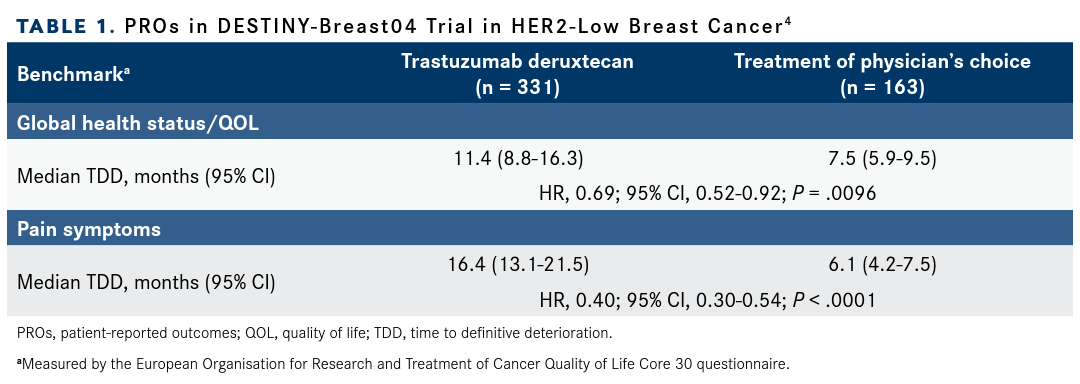Publication
Article
OS Advances Gather Steam in Breast Cancer
Author(s):
The treatment of patients with breast cancer is making noteworthy strides in several clinical settings, with recent trial results showing overall survival improvements for advanced and metastatic disease.
George W. Sledge Jr, MD

The treatment of patients with breast cancer is making noteworthy strides in several clinical settings, with recent trial results showing overall survival (OS) improvements for advanced and metastatic disease. Findings presented during the European Society for Medical Oncology Congress 2022 (ESMO 2022) underscored these gains for several novel therapies with different mechanisms of action.
Altogether, the research results represent incremental but significant advancements for patients, according to George W. Sledge Jr, MD, a 2018 Giants of Cancer Care® award winner in the breast cancer category. Sledge, a longtime professor of medicine at Stanford University in California and former chief of its Division of Oncology, joined Caris Life Sciences in mid-October 2022 as executive vice president and chief medical officer.
“Whenever you have an improvement in overall survival, that’s certainly something worth offering to patients. Even allowing for toxicities, most patients are going to accept the therapy because most of us want to live longer,” he said in an interview with OncologyLive®.
The recent flurry of findings involves new data for 3 different drug classes: antibody-drug conjugates (ADCs), CDK4/6 inhibitors, and PD-1targeting immune checkpoint inhibitors (ICIs). The most striking results have been seen with ADCs, whose efficacy is expanding into new patient populations.
ADCs Lead the Way
The first milestone was reached with fam- trastuzumab deruxtecan-nxki (Enhertu), a HER2-targeting ADC that the FDA approved in August 2022 for patients with unresectable or metastatic HER2-low breast cancer after prior therapy. The decision was based on findings from the DESTINY-Breast04 trial (NCT03734029), which showed that trastuzumab deruxtecan significantly improved median progression-free survival (PFS; (HR, 0.50; 95% CI, 0.40-0.63; P < .0001) and median OS (HR, 0.64; 95% CI, 0.49-0.84; P = .001) over physician’s choice of chemotherapy.1,2
Those results, presented amid much fanfare at the 2022 American Society of Clinical Oncology (ASCO) Annual Meeting in June,3 paved the way for expanding the indications for trastuzumab deruxtecan beyond its initial approval for metastatic HER2-positive disease and carved out a new definition for breast cancers with the potential to respond to HER2-directed therapy. HER2-low expression is defined as immunohistochemistry (IHC) 1+ or IHC 2+/in situ hybridization negative.1 Trastuzumab deruxtecan therapy also results in an improvement in quality-of-life (QOL) outcomes compared with chemotherapy, according to an analysis of patient-reported outcomes (PROs) from DESTINY-Breast04 presented at ESMO 2022 (TABLE 1).4
Table 1. PROs in DESTINY-Breast04 Trial in HER2-Low Breast Cancer4

Also at ESMO 2022, investigators reported that sacituzumab govitecan-hziy (Trodelvy), an ADC that targets TROP-2, demonstrated an OS advantage for patients with previously treated hormone receptor–positive, HER2-negative metastatic breast cancer in the TROPiCS-02 trial (NCT03901339). In the second interim analysis, sacituzumab govitecan demonstrated a statistically significant 3.2-month improvement in median OS over treatment of physician’s choice (HR, 0.79; 95% CI, 0.65-0.96; P = .02)5 (TABLE 2).5
Table 2. Updated Findings in TROPiCS-02 Trial

Sacituzumab govitecan initially was approved in April 2020 for patients with unresectable locally advanced or metastatic triple-negative breast cancer (TNBC). Gilead Sciences, Inc, the company developing the drug, has submitted a supplemental biologics license application for a new indication for the agent based on the TROPiCS-02 results.6
These data indicate the growing influence of ADCs in breast cancer, Sledge said. The first ADC for the treatment of patients with breast cancer was ado-trastuzumab emtansine (T-DM1; Kadcyla), a HER2-targeting agent that the FDA initially approved in 2013 in the metastatic setting, which was later expanded to adjuvant therapy for HER2-positive, early-stage disease.
In addition to the subsequent approvals of trastuzumab deruxtecan and sacituzumab govitecan, many other ADCs are in clinical development.7
“We’re living in the era of antibody-drug conjugates, where you pick out the cell-surface target, and you attach an antibody to some poison via a linker, then that linker is broken down to the cancer cell, releasing the poison,” Sledge said. “You get a lot of cancer cell kill because you’re able to maximize the amount of payload that’s getting to the cancer.”
Hope S. Rugo, MD, FASCO
Photo Credit: Carolyn Fong

Hope S. Rugo, MD, FASCO, who presented the TROPiCS-02 data at ESMO 2022, also stressed the impact of ADCs in the breast cancer treatment paradigm in an interview with OncLive® News Network.8
“Antibody-drug conjugates have already completely changed the way we’re thinking about delivering toxins and essentially chemotherapy to patients with advanced breast cancer and are rapidly being tested, now the second-generation antibody-drug conjugates, in a variety of settings, in the early-stage settings as well,” said Rugo. “They’ve performed better than we really could have imagined.”
Rugo, a 2020 Giants of Cancer Care® award winner in the education category, is a professor in the Department of Medicine and director of breast oncology and clinical trials education at the University of California San Francisco Helen Diller Family Comprehensive Cancer Center.
As oncologists become more experienced with using ADCs in clinical practice, they also are learning about how best to handle adverse effects. “Optimizing management of toxicities is a critical aspect and very important for practitioners,” Rugo said.
PROs are an important piece of the equation, Rugo said, noting that findings were favorable for trastuzumab deruxtecan and sacituzumab govitecan, according to analyses of DESTINY-Breast04 and TROPiCS-02 data. “Often survival trumps pretty much everything if it’s a big enough difference, but you’re always going to balance even those survival gains against the toxicities,” she said.
Sledge said the toxicity profiles of approved and emerging ADCs would be an important factor in whether they eventually will move from the metastatic to the adjuvant setting, where they would have curative potential. “There are real toxicities that are greater toxicities than we see with a naked antibody alone [that targets HER2],” Sledge said. “The real question is, how many of these drugs are exportable to the adjuvant setting… [where they are] administered to a basically healthy population of women?”
CDK 4/6 Findings Vary
For CDK4/6 inhibitors, the latest data present a more nuanced picture. Two agents in this class, ribociclib (Kisqali) and abemaciclib (Verzenio), have demonstrated OS improvements in different patient populations. Palbociclib (Ibrance), the first drug in this class to gain FDA approval in 2015, has not registered OS gains in several late-stage clinical trials.9,10
At ESMO 2022, investigators bolstered findings for ribociclib. The combination of ribociclib plus endocrine therapy (ET) improved PFS and OS compared with ET alone in patients with hormone receptor–positive, HER2-negative advanced breast cancer with visceral metastases, according to a pooled analysis of data from the phase 3 MONALEESA-2 (NCT01958021), MONALEESA-3 (NCT02422615), and MONALEESA-7 (NCT02278120) trials.11
Previously reported findings from the trials have shown statistically significant PFS and OS benefits of adding ribociclib to ET for the overall population. The new analysis focused on the impact of this strategy in clinical trial participants with visceral metastases, which indicate more aggressive disease with a worse prognosis. In this population, the use of ribociclib resulted in improvements in median PFS (HR, 0.61; 95% CI, 0.53-0.70) and median OS (HR, 0.81; 95% CI, 0.69-0.94).11
The analysis confirms the benefit of ribociclib in the first- and second-line settings, Denise A. Yardley, MD, and colleagues said. Ribociclib is approved in combination with an aromatase inhibitor (AI) as initial ET and with fulvestrant (Faslodex) as initial and progressive therapy for patients with hormone receptor–positive, HER2-negative advanced or metastatic breast cancer.12
For abemaciclib, interim OS findings also showed a positive trend pairing the agent with a nonsteroidal AI (NSAI) as first-line therapy for patients with hormone receptor–positive, HER2-negative advanced breast cancer, according to results from the phase 3 MONARCH 3 study (NCT02246621) presented at ESMO 2022.
Abemaciclib is FDA approved for this population with advanced or metastatic disease in combination with an AI as initial ET and in the second-line setting as monotherapy and in combination with fulvestrant. Additionally, abemaciclib is indicated as adjuvant therapy for patients with hormone receptor–positive, HER2-negative node-positive early breast cancer at high risk of recurrence and a Ki-67 score of 20% or higher based on results from the phase 3 monarchE trial (NCT03155997).13,14
In MONARCH 3, investigators evaluated the combination of abemaciclib or placebo plus either anastrozole or letrozole, both NSAIs, with investigator-assessed PFS as the primary end point. A “robust” PFS benefit led the FDA and regulatory bodies in other countries to approve abemaciclib plus an AI, Matthew P. Goetz, MD, and colleagues said in presenting OS data at ESMO 2022 (TABLE 3).15
Table 3. Interim OS Data in MONARCH 3 Trial

After a median follow-up of 5.8 years, findings from a preplanned second interim analysis showed a 12.6-month improvement in median OS favoring the abemaciclib arm (67.1 vs 54.5 months, respectively; P = .0301). The outcome did not reach the threshold for statistical significance, but investigators noted that abemaciclib therapy improved OS across key subgroups, including for visceral disease. A final OS analysis is expected after a planned number of events is reached in 2023.
Joyce A. O’Shaughnessy, MD

“These data are encouraging and support what we saw with monarchE in the very important adjuvant setting where we’re seeing improvements in invasive disease-free survival,” Joyce A. O’Shaughnessy, MD, said in an interview with OncLive® News Network.16 O’Shaughnessy, a 2016 Giants of Cancer Care® award winner in the community outreach/ education category, is cochair of breast cancer research, chair of breast cancer prevention research, and the Celebrating Women Chair in Breast Cancer at Baylor-Sammons Cancer Center, Texas Oncology, in Dallas, Texas.
In June 2022, investigators reported further data from monarchE involving a subset of participants (2056 of 5637 patients) who received neoadjuvant chemotherapy followed by ET with or without abemaciclib in JAMA Oncology. Among these patients, treatment with abemaciclib resulted in a 39% reduction in the risk of developing invasive disease compared with ET alone (HR, 0.61; 95% CI, 0.47-0.80; P < .001) and a 6.7% improvement in 2-year distant relapse-free survival (89.5% vs 82.8%, respectively).17
The OS data reported at ESMO 2022 build on the body of knowledge that has been accumulating about an important class of agents, Sledge said. Ribociclib and abemaciclib “have significantly improved overall survival in both the frontline and the second-line setting in an area where, literally for decades, we basically saw no improvement in terms of overall survival. These are real advances.”
In the adjuvant setting, Sledge said, future findings would show whether the disease-free survival benefit shown with abemaciclib translates into an OS improvement. “There’s still a lot to learn, but certainly there’s enough data from the metastatic setting and from the early data in the adjuvant setting to suggest that these [agents] may have a long-lasting impact in terms of improving ultimate outcomes for patients with the disease.”
Other important questions involving CDK4/6 inhibitors involve strategies for patients whose tumors are resistant to initial therapy with these agents or progress after treatment. “The CDK4/6 inhibitors have been transformative in the lives of patients with hormone receptor–positive, HER2-negative breast cancer in the first-line setting but there still are patients who don’t get that median 2-year progression-free survival,” O’Shaughnessy said.
She noted that results of a mutational signature analysis presented at ESMO 2022 helps to advance the understanding of resistance to CDK4/6 inhibition plus ET. Investigators used the MSK-IMPACT targeted gene panel to sequence approximately 4500 breast cancer samples. They found that estrogen receptor–positive, HER2-negative tumors with higher signatures for the APOBEC family of cytidine deaminases and for homologous recombination deficiency are associated with shorter PFS on first-line ET plus a CDK4/6 inhibitor.18
For patients whose tumors progress after treatment with a CDK4/6 inhibitor, findings from the phase 2 MAINTAIN trial (NCT02632045) that explored switching therapy might prove helpful, Sledge noted. The study randomly assigned 119 patients with hormone receptor–positive, HER2-negative metastatic breast cancer who developed resistance to ET plus a CDK4/6 inhibitor to subsequent therapy with a different ET with or without ribociclib. Fulvestrant was used as ET in patients who had progressed on a prior AI whereas exemestane was permitted for those who had progressed on prior fulvestrant. Approximately 87% of the participants had received palbociclib as prior therapy.19
After a median follow-up of 18.2 months, the median PFS was 5.29 months (95% CI, 3.02-8.12) with ribociclib plus ET compared with 2.76 months (95% CI, 2.66-3.25) with placebo plus ET (HR, 0.57; 95% CI, 0.39-0.95; P = .006). The PFS rates with ribociclib were 41.2% at 6 months and 24.6% at 12 months vs 23.9% and 7.4%, respectively, with placebo.19
Sledge said the study “points to an important question that we all have to deal with: Once we’ve had a major success, but we don’t cure the patient, what do we do next? That’s another broad challenge for the field as a whole.”
ICIs Make Mark in Early-Stage TNBC
Recent clinical trial findings also point to advancements in the use of immunotherapy. In July 2022, investigators reported findings from the phase 3 KEYNOTE-355 study (NCT02819518) evaluating pembrolizumab (Keytruda), a PD-1 inhibitor, in patients with triple-negative breast cancer (TNBC), in the New England Journal of Medicine (NEJM).20
The addition of pembrolizumab to chemotherapy demonstrated significantly longer OS compared with chemotherapy alone in patients with previously untreated locally recurrent inoperable or metastatic TNBC whose tumors express PD-L1 with a combined positive score (CPS) of 10 or more (CPS-10). (The CPS reflects the number of PD-L1–staining tumor cells, lymphocytes, and macrophages divided by the total number of tumor cells multiplied by 100).
In November 2020, the FDA granted an accelerated approval for pembrolizumab for this patient population based on PFS findings from KEYNOTE-355.21 The study involved 847 patients who were randomly assigned 2:1 to receive chemotherapy with or without pembrolizumab, including 323 participants (38.1%) in the CPS-10 subgroup.20
After a median follow-up of 44.1 months, the median OS among patients in the CPS-10 cohort was 23.0 months (95% CI, 19.0-26.3) for those who treated with pembrolizumab and 16.1 months (95% CI, 12.6-18.8) for those who received placebo, according to results of the final analysis. Pembrolizumab reduced the risk of death by 27% (HR, 0.73; 95% CI, 0.55-0.95) with a 2-sided P value of .0185, which crossed the prespecified threshold for statistical significance.20
Pembrolizumab also is approved in combination with chemotherapy as neoadjuvant treatment for patients with high-risk, early-stage TNBC, followed by surgery and pembrolizumab monotherapy. The FDA granted the approval based on findings from the phase 3 KEYNOTE-522 study (NCT03036488), in which 1174 patients were randomly assigned 2:1 to receive neoadjuvant chemotherapy with or without pembrolizumab. The trial recruited patients with tumors greater than 1 cm and a maximum of 2 cm or smaller in diameter with nodal involvement or tumor size greater than 2 cm in diameter regardless of nodal involvement.22
At the time, the pathological complete response (pCR) rate was 63% (95% CI, 59.5%-66.4%) with the pembrolizumab-containing regimen compared with 56% (95% CI, 50.6%-60.6%) with chemotherapy alone.
In February 2022, investigators reported eventfree survival (EFS) data from KEYNOTE-522 in NEJM. At 36 months, the EFS rate was 84.5% (95% CI, 81.7%-86.9%) in the pembrolizumab plus chemotherapy arm vs 76.8% (95% CI, 72.2%-80.7%) for those who received chemotherapy alone (HR, 0.63; 95% CI, 0.48- 0.82; P < .001).23
The efficacy of pembrolizumab in the neoadjuvant setting was supported by results of a network meta-analysis presented at ESMO 2022. Investigators compared pCR and EFS rates reported in clinical trials of pembrolizumab plus chemotherapy vs chemotherapy alone as neoadjuvant therapy followed by adjuvant treatment. For pCR, the analysis showed that the pembrolizumab-containing regimen had a statistically favorable pCR rate compared with 3 of 7 chemotherapy-alone regimens (ORs for pembrolizumab ranging from 1.36, 1.89, and 3.12). For EFS rates, the use of pembrolizumab was statistically favorable to 3 of 5 regimens (HRs favoring pembrolizumab of 0.36, 0.57, and 0.63).24
Investigators concluded that neoadjuvant pembrolizumab plus chemotherapy followed by adjuvant pembrolizumab “is an effective treatment relative to most competing interventions” in the neoadjuvant setting.
Although defining a role for ICI therapy in metastatic TNBC has been problematic, Sledge said, findings for earlier stages of disease have been encouraging so far. “There is clear and compelling evidence of benefit and, as a result, excitement about these agents for their potential to improve the outcomes for patients with triple-negative breast cancer.”
Looking forward, Sledge said unsettled questions include whether there is an OS benefit with neoadjuvant ICI therapy in patients with TNBC and which biomarkers might predict responses to therapy. He also noted that so far investigators have focused on testing ICIs in TNBC but that future research might show a role in other breast cancer subtypes.
“The reason we do the trials is the same reason that you play basketball games,” Sledge said. “Even when you have 2 teams on the [court], and you think 1 is better than another, at the end of the game the score may tell you that you were wrong. We need to actually play the contest and see what the final score is.”
References
- FDA approves fam-trastuzumab deruxtecan-nxki for HER2-low breast cancer. FDA. August 5, 2022.https://bit.ly/3CfNIgs
- Modi S, Jacot W, Yamashita T, et al; DESTINY-Breast 04 trial investigators. Trastuzumab deruxtecan in previously treated HER2-low advanced breast cancer. N Engl J Med. 2022;387(1):9-20. doi:10.1056/NEJMoa2203690
- Modi S, Jacot W, Yamashita T, et al. Trastuzumab deruxtecan (T-DXd) versus treatment of physician’s choice (TPC) in patients (pts) with HER2-low unresectable and/or metastatic breast cancer (mBC): results of DESTINY-Breast04, a randomized, phase 3 study. J Clin Oncol. 2022;40 (suppl 17):abstr LBA3. doi:10.1200/JCO.2022.40.17_suppl.LBA3
- Ueno NT, Jacot W, Yamashita T, et al. Patient-reported outcomes (PROs) from DESTINY-Breast04, a randomized phase 3 study of trastuzumab deruxtecan (T-DXd) vs treatment of physician’s choice (TPC) in patients (pts) with HER2-low metastatic breast cancer (MBC). Ann Oncol. 2022;33(suppl 7): S88-S121. doi:10.1016/annonc/annonc1040
- Rugo HS, Bardia A, Marme F, et al. Overall survival (OS) results from the phase III TROPiCS-02 study of sacituzumab govitecan (SG) vs treatment of physician's choice (TPC) in patients (pts) with HR+/HER2- metastatic breast cancer (mBC). Ann Oncol. 2022;33(suppl 7):LBA76. doi:10.1016/annonc/annonc1089
- Trodelvy significantly improves overall survival in pre-treated HR+/HER2- metastatic breast cancer patients in the TROPiCS-02 study. News release. Gilead Sciences, Inc. August 15, 2022. Accessed October 4, 2022. https://bit.ly/3yiiEKC
- Koster KL, Huober J, Joerger M. New antibody-drug conjugates (ADCs) in breast cancer—an overview of ADCs recently approved and in later stages of development. Explor Target Antitumor Ther. 2022;3(1):27-36. doi:10.37349/etat.2022.00069
- Advances in breast and gastrointestinal cancers at ESMO 2022: Drs Rugo and Abou-Alfa. OncLive®News Network: On Location at ESMO 2022—Episode 1. September 10, 2022. Accessed October 4, 2022. https://bit.ly/3e4Bn5g
- Liu A. ASCO: Pfizer's Ibrance fails to extend lives in newly diagnosed breast cancer. Will doctors switch gears to Novartis, Lilly?Fierce Pharma. June 2, 2022. Accessed October 6, 2022. https://bit.ly/3Cfj45nIbrance.
- Prescribing information. Pfizer Inc; 2019. Accessed October 6, 2022. https://bit.ly/3rAPYbL
- Yardley DA, Yap YS, Azim HA, et al. Pooled exploratory analysis of survival in patients with HR+/HER2– advanced breast cancer and visceral metastases treated with ribociclib + endocrine therapy in the MONALEESA trials. Ann Oncol. 2022;33(suppl 7):S85-S87. doi:10.1016/annonc/annonc1039
- Kisqali. Prescribing information. Novartis Pharmaceuticals Corporation; 2021. Accessed October 6, 2022. https://bit.ly/3Eq9lvQ
- Verzenio. Prescribing information. Eli Lilly and Company; 2021. Accessed October 6, 2022. https://bit.ly/3SJdwY7
- FDA approves abemaciclib with endocrine therapy for early breast cancer. FDA. October 13, 2021. Accessed October 3, 2022. https://bit.ly/3e9IOZ0
- Goetz MP, Toi M, Huober J, et al. MONARCH 3: Interim overall survival (OS) results of abemaciclib plus a nonsteroidal aromatase inhibitor (NSAI) in patients (pts) with HR+, HER2- advanced breast cancer (ABC). Ann Oncol. 2022;33(suppl 7)):S808-S869. doi: 10.1016/annonc/annonc1089
- Breaking down treatment developments in breast and genitourinary cancers from ESMO 2022: Drs O'Shaughnessy and Choueiri. OncLive® News Network: On Location at ESMO 2022—Episode 1. September 12, 2022. Accessed October 6, 2022.https://bit.ly/3fPQLTO
- Martin M, Hegg R, Kim SB, etal. Treatment with adjuvant abemaciclib plus endocrine therapy in patients with high-risk early breast cancer who received neoadjuvant chemotherapy. JAMA Oncol. 2022;8(8):1190-1194. doi:10.1001/jamaoncol.2022.1488
- Marra A, Gazzo A, Gupta A,etal. Mutational signature analysis reveals patterns of genomic instability linked to resistance to endocrine therapy (ET) +/- CDK 4/6 inhibition (CDK4/6i) in estrogen receptor-positive/HER2-negative (ER+/HER2-) metastatic breast cancer (MBC). Ann Oncol. 2022;33(suppl7): S88-S121.doi:10.1016/annonc/annonc1040
- Kalinsky K, Accordino MK, Chiuzan C, et al. A randomized, phase II trial of fulvestrant or exemestane with or without ribociclib after progression on anti-estrogen therapy plus cyclin-dependent kinase 4/6 inhibition (CDK 4/6i) in patients (pts) with unresectable or hormone receptor–positive (HR+), HER2-negative metastatic breast cancer (MBC): MAINTAIN trial.J Clin Oncol. 2022;40(suppl 17): LBA1004.doi:10.1200/JCO.2022.40.17_suppl.LBA1004
- Cortes J, Rugo HS, Cescon DW, et al; KEYNOTE-355 Investigators. Pembrolizumab plus chemotherapy in advanced triple-negative breast cancer. N Engl J Med. 2022;387(3):217-226. doi:10.1056/NEJMoa2202809
- FDA grants accelerated approval to pembrolizumab for locally recurrent unresectable or metastatic triple negative breast cancer. FDA. November 13, 2020. Accessed October 7, 2022.https://bit.ly/3CjBSAI
- FDA approves pembrolizumab for high-risk early-stage triple-negative breast cancer. FDA. July 27, 2022. Accessed October 8, 2022. https://bit.ly/3SU6yzG
- Schmid P, Cortes J, Dent R, et al. KEYNOTE-522 Investigators. Event-free survival with pembrolizumab in early triple-negative breast cancer. N Engl J Med. 2022;386(6):556-567. doi:10.1056/NEJMoa2112651
- Cortés J, Haiderali A, Huang M, et al. Neoadjuvant pembrolizumab + chemotherapy followed by adjuvant pembrolizumab for treatment of high-risk, early-stage triple-negative breast cancer: a network meta-analysis.Ann Oncol. 2022;33 (suppl7): S55-S84. doi:10.1016/annonc/annonc1038








